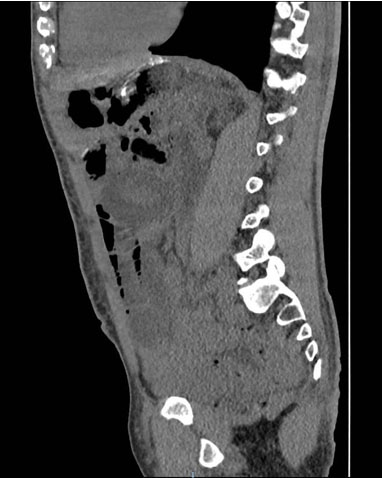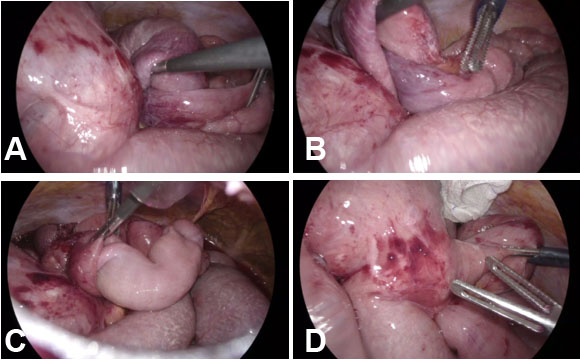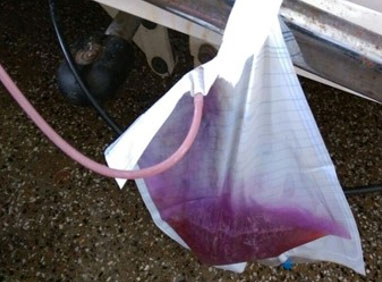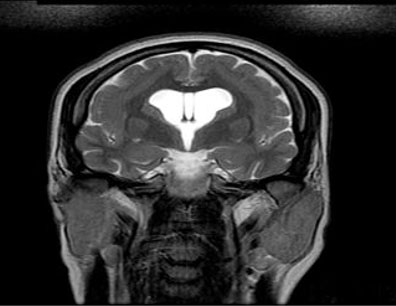 |
Case Report
Small bowel intussusception after Roux-en-Y gastric bypass: A case report
1 General Surgery Resident, General Surgery Department, Hospital do Espírito Santo de Évora, EPE, Évora, Portugal
2 General Surgery Consultant, General Surgery Department, Hospital do Espírito Santo de Évora, EPE, Évora, Portugal
3 Head of Department of General Surgery, General Surgery Department, Hospital do Espírito Santo de Évora, EPE, Évora, Portugal
Address correspondence to:
Joana Oliveira
Hospital do Espírito Santo de Évora, EPE, Largo do Senhor da Pobreza, 7000-811 Évora,
Portugal
Message to Corresponding Author
Article ID: 100117Z06JO2023
Access full text article on other devices

Access PDF of article on other devices

How to cite this article
Oliveira J, Bolota J, Lima R, Velez C, Amaro M, Carvalho M. Small bowel intussusception after Roux-en-Y gastric bypass: A case report. Case Rep Int 2023;12(1):23–28.ABSTRACT
Introduction: Small bowel intussusception after Rouxen-Y gastric bypass is a rare condition, with a reported incidence of 0.07–0.6%, and a multifactorial etiology. The severity of the condition ranges from small bowel edema to ischemia and perforation with peritonitis, and the clinical presentation and blood tests are non-specific. The computed tomography (CT) scan is the best diagnostic tool in an emergency department context.
Case Report: The authors present the case of a 41-year-old male patient, with history of Roux-en-Y gastric bypass two years before, who presented in the emergency department with acute onset abdominal pain and nausea. Abdominal exploration showed a tender mass in the left upper quadrant. Blood tests showed an increase in alanine transaminase (ALT) and aspartate transaminase (AST) and abdominal CT scan was compatible with a small bowel intussusception, without other findings. A diagnostic laparoscopy confirmed the diagnosis, and the intussusception was resolved without need of bowel resection. The patient showed no complications in the immediate post-operative period, with clinical and analytical improvement, and was discharged on the sixth post-operative day, without relevant complaints in the follow-up appointments.
Conclusion: Due to the non-specific clinical presentation of small bowel intussusception, it is required a high level of suspicion in patients who underwent gastric bypass and present with abdominal pain. In terms of surgical approach, resolution of the intussusception may be enough in many cases, when there is no vascular compromise of the bowel, while the evidence of ischemia requires bowel resection.
Keywords: Obesity surgery, Roux-en-Y gastric bypass, Small bowel intussusception
INTRODUCTION
Obesity is a major public health problem, with increasing prevalence worldwide. In 2022, WHO data estimate that, in Europe, 58.7% of the adult population is overweight, with a prevalence of obesity of 23.3%. According to the same source, in Portugal, prevalence of overweight and obesity are 57.5% and 20.8%, respectively [1].
Metabolic and bariatric surgery (MBS) practice has increased throughout the last decades, with long-term studies proving that MBS is a safe, effective, and durable treatment for severe obesity, with superior weight loss outcomes when compared to non-operative treatments, and a positive impact in its co-morbidities and mortality. Based on these results, the American Society for Metabolic and Bariatric Surgery (ASMBS) and International Federation for the Surgery of Obesity and Metabolic Disorders (IFSO) published, in 2022, an update on the indications for MBS, expanding it for individuals with a body mass index (BMI) >35 kg/m2, regardless of presence, absence, or severity of co-morbidities, and stating that it should be considered for individuals with metabolic disease and BMI of 30–34.9 kg/m2 [2]. These recommendations predict a major increase in the number of MBS in the next years.
Roux-en-Y gastric bypass (RYGBP) is the second most performed MBS technique in Portugal and worldwide, accounting to 31.2% of procedures, only being superseded by sleeve gastrectomy [3]. Long-term complications are not uncommon after gastric bypass and can lead to reoperation in 3–20% of the patients. Bowel obstruction is one of the possible complications, with an incidence of 0.5–5%, with the main causes being internal hernia and adhesions [4],[5],[6],[7],[8],[9]. Small bowel intussusception after RYGBP is a rare but potentially severe cause of obstruction, with a reported incidence of 0.07–0.6% [4],[9].
CASE REPORT
A 41-year-old male patient presented to the emergency department with diffuse abdominal pain and nausea, with acute onset 8 hours before. The patient had a history of laparoscopic cholecystectomy 9 years before, and underwent a RYGBP 2 years before, with a reported weight loss of 60 kg (initial weight of 135 kg, initial BMI of 41.7 kg/m2, present weight of 75 kg, present BMI of 23.1 kg/m2). There was no other relevant medical history.
On physical exploration, vital signs were stable, and a tender mass was palpable in the left upper quadrant of the abdomen, without signs of peritoneal irritation. Blood tests showed an ALT 176 U/L and AST 182 U/L, without other relevant findings.
The abdominal computed tomography (CT) scan showed small bowel distension, without pneumoperitoneum or free peritoneal fluid, and characteristic “target sign” (Figure 1) and “pseudokidney sign” (Figure 2A and Figure 2B), compatible with a small bowel intussusception. The patient underwent a diagnostic laparoscopy that confirmed the diagnosis, showing a retrograde intussusception at the jejunojejunal anastomosis, which was managed with laparoscopic reduction (Figure 3A, Figure 3B, Figure 3C, Figure 3D). At the end of this procedure, the viability of the intestinal segment involved was confirmed, showing some vascular congestion but without signs of ischemia, without necessity of any resection.
The patient showed no complications in the immediate post-operative period, with clinical and analytical improvement, tolerating oral diet and with bowel function reestablished, and was discharged on the sixth post-operative day. Two years after surgery, the patient remains asymptomatic and without recurrence of intussusception.
DISCUSSION
Small bowel intussusception is a rare condition in adults, being responsible for about 1% of all bowel obstructions [10]. It is mainly associated with a “lead point” (such as a tumor, a Meckel’s diverticulum, or a lipoma) that causes the prolapse of the affected segment of bowel into the adjacent nonaffected segment, usually in an anterograde fashion (the proximal segment invaginates into the distal segment) [4].
Nevertheless, after RYGBP, the incidence of intussusception ranges between 0.07% and 0.6% [4],[9], although it is reasonable to believe that the real incidence is higher, as some patients have no imaging findings of intussusception and others spontaneously reduce prior to operative confirmation. This is a late complication, manifesting on average 3.6 years after surgery, but the reports in literature range between a few months to more than 20 years after surgery [4],[11],[12].
The majority of patients are females (85% in retrospective studies and 98% in case reports), which may, in part, be explained by the fact that the majority of patients undergoing RYGBP are females [9]. Despite this, there is a discrepancy between the incidence of intussusceptions in females and the proportion of women in the population undergoing RYGBP (70–80%), which may be associated to some sex or hormonal unknown factors, with more studies being needed [4],[13].
In 2021, Oor et al. published a systematic review and meta-analysis [9] including 6 retrospective studies, with 107 patients, and 68 case reports, including 84 patients, being the most comprehensive review published so far on this matter.
The pathophysiological mechanisms for this condition are not well understood, and it is believed to have a multifactorial etiology, probably due to a disruption of the natural intestinal pacemakers and thinning of the mesentery associated with significant weight loss [4],[5],[7],[9],[12],[13],[14],[15].
- Disruption of the intestinal pacemakers—intestinal motility is initiated in the duodenum, being enhanced after meals, to promote the propulsion of chime throughout the intestine. With jejunal transection to the construction of the Roux limb, distal jejunum becomes separated from duodenal pacemaker cells, causing ectopic pacemakers to arise in the Roux limb, producing both anterograde and retrograde peristalsis. Subsequently, jejunojejunal anastomosis becomes a meeting point of anterograde peristalsis originating in the duodenum and retrograde peristalsis originating in these ectopic pacemakers, resulting in intussusception [4],[9].
- Thinning of the mesentery subsequent to significant weight loss—in their review, Oor et al. [9] concluded that the mean interval between RYGBP and intussusception is 4.8 years, in patients with a mean BMI of 28.1 kg/m2. The significant weight loss, and subsequent thinning of the mesentery, increases the mobility around the jejunojejunal anastomosis, making it a susceptible place to an intussusception.
Intussusception after RYGBP mainly involves the jejunojejunal anastomosis in a retrograde fashion (although there are a few cases of anterograde intussusception reported) and usually no lead point is identified. The reason why some patients develop an intussusception in an antegrade fashion and others in a retrograde fashion remains unclear [4],[9].
Post-operative adhesions, nodal hyperplasia, or the creation of a long jejunojejunal anastomosis stapling line were also suggested to act as a lead point for intussusception, but more studies are needed to investigate this possible association [4],[9],[12].
The severity of the condition ranges from small bowel edema to ischemia, with around 38% of patients showing signs of bowel ischemia (with or without perforation and peritonitis) on surgical exploration [9], so an early diagnosis is essential.
The diagnosis of intussusception is difficult and requires a high degree of suspicion, as the clinical presentation is non-specific, usually with abdominal pain, nausea, and vomiting. Other clinical findings may be the presence of a palpable mass, hematemesis, bloody diarrhea, or peritoneal irritation. If intussusception leads to isolated obstruction of the biliopancreatic limb, common signs of obstruction will be absent. Physical examination is not conclusive in most patients. There is an important variation in the duration of symptoms and intensity of pain, with more acute and severe presentation usually associated with a complete intussusception with small bowel obstruction and strangulation, and a partial, intermittent intussusception associated with mild, intermittent, and sometimes chronic symptoms, being a possible cause of “unexplained” intermittent abdominal pain after RYGBP [4],[9].
Blood tests may be normal or show inflammation markers elevation. The overdistension of biliopancreatic limb due to intussusception may cause elevation of pancreatic or liver tests [4].
The abdominal CT scan is the best diagnostic tool in an emergency department context. The most typical features are the “target sign” (Figure 1) and the “pseudokidney sign” (Figure 2 and Figure 3). Other less specific features may be present, like segmental bowel distension with or without air-fluid levels, or isolated distension of the biliopancreatic limb, duodenum, and gastric remnant [4],[9].
However, the absence of signs of intussusception on CT scan does not completely rule out this diagnosis, with Orthopoulos et al. [12] reporting less than 70% of patients with intussusception on surgical exploration with preoperative radiological findings on the CT scan. This shows the importance of exploratory laparoscopy or laparotomy in patients who underwent RYGBP that show up with severe abdominal pain and vomiting, without radiological signs [4].
Magnetic resonance imaging (MRI) may be hypothesized in pregnant patients, as long as it doesn’t represent a delay in definitive treatment [9].
Surgery is the treatment of choice in bowel intussusception, due to the high risk of ischemia. Surgical techniques may be divided into three main groups: reduction of the intussusception alone, reduction with enteropexy/plication, and resection and revision of the jejunojejunal anastomosis [4],[9],[16]
- Reduction alone—this is a relatively noninvasive procedure that allows the preservation of the bowel length and avoids the potential complications associated with a new anastomosis. It remains a valid option in the non-ischemic bowel, since intussusception after RYGBP usually doesn’t have a lead point that requires excision.
- Reduction with enteropexy/plication—this consists of fixating the common channel to the biliopancreatic or the alimentary limb.
- Bowel resection and revision of jejunojejunal anastomosis—it is mandatory if there is intestinal necrosis. The main advantage of resection is a lower recurrence rate associated with a low reported morbidity.
In many cases, despite the initial concerning physical exam or imaging findings, at the time of the surgical exploration there is a complete resolution of the intussusception, without need of any additional procedures [12].
Recurrence rates are not well established in literature, due to the heterogeneity of data report, but in a retrospective study including 665 patients, 34 of which with intussusception after RYGBP, Orthopoulos et al. found a recurrence rate of 26.5% (8 patients), being 4 after enteropexy alone, 1 after reduction with enteropexy, 1 after resection, and 2 after diagnostic laparoscopy [12]. Daellenbach et al. [4] reported a significantly higher recurrence rate following reduction with or without plication compared to resection (33.3% vs 7.7%, respectively; p = 0.02).
The ideal treatment for intussusception after RYGBP remains unclear, with the majority of patients being treated with reduction and/or enteropexy, in some series even after recurrence [12]. Due to high incidence of ischemia reported in literature, some authors advocate for a very low threshold for resection and subsequent revision of jejunojejunal anastomosis [9].
CONCLUSION
Due to the non-specific clinical presentation of small bowel intussusception, it is required a high level of suspicion in patients who were submitted to bariatric surgery and present with abdominal pain. In terms of surgical approach, resolution of the intussusception may be enough in some cases, when there is no vascular compromise of the bowel, while others may require bowel resection.
Therefore, small bowel intussusception is a potentially life-threatening condition (with around 38% of patients showing signs of bowel ischemia on surgical exploration) that must be considered in the differential diagnosis of unspecific abdominal pain in patients after RYGBP, especially after a significant weight loss.
REFERENCE
1.
2.
Eisenberg D, Shikora SA, Aarts E, et al. 2022 American Society for Metabolic and Bariatric Surgery (ASMBS) and International Federation for the Surgery of Obesity and Metabolic Disorders (IFSO): Indications for metabolic and bariatric surgery. Surg Obes Relat Dis 2022;18(12):1345–56. [CrossRef]
[Pubmed]

4.
Daellenbach L, Suter M. Jejunojejunal intussusception after Roux-en-Y gastric bypass: A review. Obes Surg 2011;21(2):253–63. [CrossRef]
[Pubmed]

5.
Ma IT, Madura JA 2nd. Gastrointestinal complications after bariatric surgery. Gastroenterol Hepatol (N Y) 2015;11(8):526–35.
[Pubmed]

6.
Husain S, Ahmed AR, Johnson J, Boss T, O’Malley W. Small-bowel obstruction after laparoscopic Roux-en-Y gastric bypass: Etiology, diagnosis, and management. Arch Surg 2007;142(10):988–93. [CrossRef]
[Pubmed]

7.
Coster DD, Sundberg SM, Kermode DS, Beitzel DT, Noun SH, Severidt M. Small bowel obstruction due to antegrade and retrograde intussusception after gastric bypass: Three case reports in two patients, literature review, and recommendations for diagnosis and treatment. Surg Obes Relat Dis 2008;4(1):69–72. [CrossRef]
[Pubmed]

8.
Elms L, Moon RC, Varnadore S, Teixeira AF, Jawad MA. Causes of small bowel obstruction after Rouxen-Y gastric bypass: A review of 2,395 cases at a single institution. Surg Endosc 2014;28(5):1624–8. [CrossRef]
[Pubmed]

9.
Oor JE, Goense L, Wiezer MJ, Derksen WJM. Incidence and treatment of intussusception following Roux-en-Y gastric bypass: A systematic review and meta-analysis. Surg Obes Relat Dis 2021;17(5):1017–28. [CrossRef]
[Pubmed]

10.
Potts J, Al Samaraee A, El-Hakeem A. Small bowel intussusception in adults. Ann R Coll Surg Engl 2014;96(1):11–4. [CrossRef]
[Pubmed]

11.
Uribe AF, Arévalo JAG, Contreras CG, Mendoza RT, Uribe OAF. Unique long-term simultaneous complications of conventional Roux-en-Y gastric bypass after 27 years: A case report. Int J Surg Case Rep 2022;101:107787. [CrossRef]
[Pubmed]

12.
Orthopoulos G, Grant HM, Sharma P, Thompson E, Romanelli JR. S054: Incidence and management of jejunojejunal intussusception after Roux-en-Y gastric bypass: A large case series. Surg Endosc 2020;34(5):2204–10. [CrossRef]
[Pubmed]

13.
Singla S, Guenthart BA, May L, Gaughan J, Meilahn JE. Intussusception after laparoscopic gastric bypass surgery: An underrecognized complication. Minim Invasive Surg 2012;2012:464853. [CrossRef]
[Pubmed]

14.
Tu BN, Kelly KA. Motility disorders after Roux-en-Y gastrojejunostomy. Obes Surg 1994;4(3):219–26. [CrossRef]
[Pubmed]

15.
Machado A, Carvalho M, Caravana J. Laparoscopic resolution of intussusception after Roux-en-Y gastric bypass. Surg Obes Relat Dis 2018;14(12):1916–8. [CrossRef]
[Pubmed]

16.
Stephenson D, Moon RC, Teixeira AF, Jawad MA. Intussusception after Roux-en-Y gastric bypass. Surg Obes Relat Dis 2014;10(4):666–70. [CrossRef]
[Pubmed]

SUPPORTING INFORMATION
Acknowledgement
The authors would like to thank Artur Silva, MD, Ânia Laranjeira, MD, Arnaldo Machado, MD, and Margarida Cinza, MD for their contribution to this paper.
Author ContributionsJoana Oliveira - Conception of the work, Design of the work, Acquisition of data, Analysis of data, Drafting the work, Revising the work critically for important intellectual content, Final approval of the version to be published, Agree to be accountable for all aspects of the work in ensuring that questions related to the accuracy or integrity of any part of the work are appropriately investigated and resolved.
Joana Bolota - Conception of the work, Design of the work, Acquisition of data, Analysis of data, Drafting the work, Revising the work critically for important intellectual content, Final approval of the version to be published, Agree to be accountable for all aspects of the work in ensuring that questions related to the accuracy or integrity of any part of the work are appropriately investigated and resolved.
Rita Lima - Conception of the work, Design of the work, Revising the work critically for important intellectual content, Final approval of the version to be published, Agree to be accountable for all aspects of the work in ensuring that questions related to the accuracy or integrity of any part of the work are appropriately investigated and resolved.
Cristina Velez - Conception of the work, Design of the work, Revising the work critically for important intellectual content, Final approval of the version to be published, Agree to be accountable for all aspects of the work in ensuring that questions related to the accuracy or integrity of any part of the work are appropriately investigated and resolved.
Margarida Amaro - Conception of the work, Design of the work, Revising the work critically for important intellectual content, Final approval of the version to be published, Agree to be accountable for all aspects of the work in ensuring that questions related to the accuracy or integrity of any part of the work are appropriately investigated and resolved.
Manuel Carvalho - Conception of the work, Design of the work, Revising the work critically for important intellectual content, Final approval of the version to be published, Agree to be accountable for all aspects of the work in ensuring that questions related to the accuracy or integrity of any part of the work are appropriately investigated and resolved.
Guarantor of SubmissionThe corresponding author is the guarantor of submission.
Source of SupportNone
Consent StatementWritten informed consent was obtained from the patient for publication of this article.
Data AvailabilityAll relevant data are within the paper and its Supporting Information files.
Conflict of InterestAuthors declare no conflict of interest.
Copyright© 2023 Joana Oliveira et al. This article is distributed under the terms of Creative Commons Attribution License which permits unrestricted use, distribution and reproduction in any medium provided the original author(s) and original publisher are properly credited. Please see the copyright policy on the journal website for more information.








